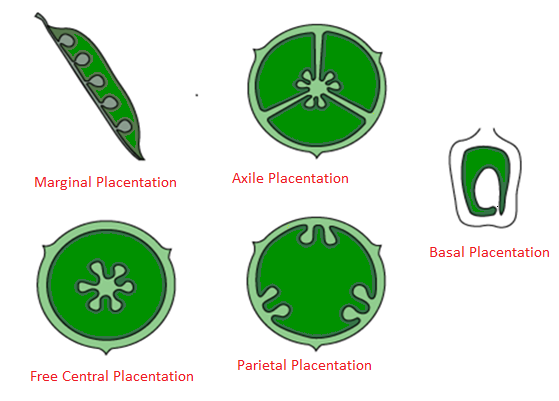The arrangement of ovules within the ovary is known as placentation. What does the term placenta refer to? Draw various types of placentations in the flower as seen in T.S. and V.S.
Placenta is a tissue which is flattened, cushion-like tissue. Through placenta ovule is attached to the wall of the ovary.
Placentations are of many types like marginal, axile, pariental, basal, central and free central.
In Marginal Placentations the placenta forms a ridge along the ventral suture of the ovary and the ovules are borne on this ridge forming two rows, as in pea. This is found in monocarpellary, unilocular ovary.
In Axile Placentations the ovules are borne on central axis and the marginal of placenta grow inward and fuse, thus making a multilocular ovary, as in China rose, tomato, etc. Here numbers of locules are as many as the carpels.
In Parietal Placentations the ovules develop on the inner wall of the ovary or on peripheral part. Ovary is one chambered but it becomes two chambered due to the formation of a false septum known as replam, e.g., mustard, argemone. Here the placentae develop on the ovary wall and the number of placentae is equal to the number of carpels.
In Free Central Placentations the ovules are present on the central axis of ovary and septa is absent so ovary is unilocular, as in Dianthus and Primose. A single large swollen placenta arises from base of the ovary. It bears a number of ovules all over its surface.
In Basal Placentations the placenta develops at the base of ovary and a single ovule is attached to it, as in sunflower, marigold, etc.
Placenta function is to supply nutrients to the developing embryo.
